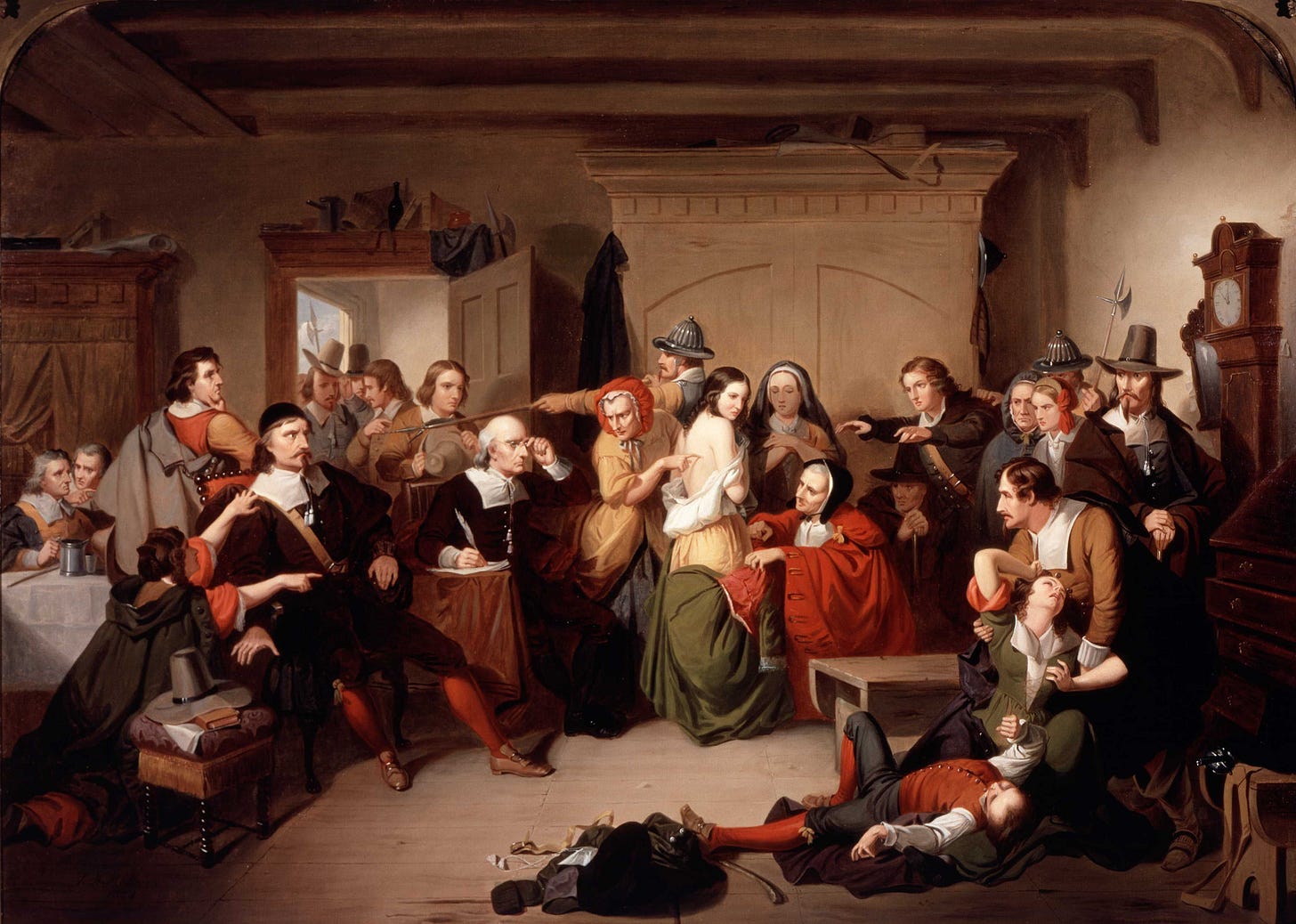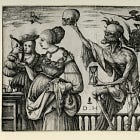When I was ten years old my best friend told me I had witches feet.
We were in gym class — already a minefield for girls hovering just at the edge of puberty, with its tight leotards and its cult of flexibility and its cruel P.E teachers, who spent more time cultivating their coterie of favourites than teaching. We had to wear a garish purple leotard, without tights or socks, and underwear was only permitted if it didn’t peek beyond the seams. I was already bad at gym class, a lanky, scrawny child with inflexible hamstrings and bony, lumpen feet three sizes larger than anyone else in my class. But the moment I took my socks off, I was doomed.
Ugh! Gross. You have witches feet!
My cheek’s flushed the colour of my saggy leotard and I attempted to hide the offending appendages beneath my hands. But there was no hiding from this. My friend had unwittingly pointed out an incontrovertible truth. I had ugly feet. I would always have ugly feet. And in doing so, she had inculcated in me a new awareness of my body. By identifying me as both an embodied creature, and one that was flawed in some physically and perhaps morally suspect way, she had left a deep and lasting wound.
I refused to take my socks off for the rest of my uninspiring high school P.E. career. I’d always manage to find an excuse — that I had a cut and was worried about verrucas — or straight up refuse. I didn’t want anyone to see my witches feet, which disgusted me, made me cry in shoe shops and at ballet class, where a teacher once told me I could never be a ballerina, because I’d never fit the pumps. Later, when I developed chilblains as a malnourished teenager, I fretted through the yoga classes I was taking in a half-hearted effort to manage my mental health. The woman behind me — likely slightly older, glamorous, her head tightly screwed on and topped off with a perfect blonde ponytail — would have a prime view of my horribly deformed toes.
That moment of attention I experienced in gym class, the sudden flush of awareness of both my physical embodiment and that body’s flaws, occasioned by their unintended revelation, has repeated throughout my life like a recurring pimple in the same stubborn spot. As a girl in the noughties, inundated by images of the ultra-thin body and the prevailing cultural fear of fatness, my body dysmorphia certainly didn’t develop in a vacuum, but I can pinpoint its manifestation to a single trigger. Leaping onto a swing as a kid, my favourite dress — black and white, with cheerful polka-dots — flew up to expose my thighs, squashed pink against the seat. The horror was visceral, an overwhelmingly physical disgust at the animal I suddenly and unexpectedly recognised as myself and a deep sense of shame. I hid the polka-dot dress in the back of my wardrobe and never wore it again. Sometimes I’d take it out, just to look at it, but I’d always stuff it back to languish with boxes of unloved toys and forgotten board games. I was maybe six. I have hated my body — hated it actively and aggressively, with few moments of reprieve — from that moment onwards.
I don’t think I’m unique in these experiences. I don’t think its uncommon for girls to learn to hate themselves early, the beginning of a lifelong accumulation of moments of realisation that our bodies are doomed to refuse the perfect ideal we are expected to conform to, indeed that we have a body at all and do not just exist as the outward manifestation of our thoughts or imaginations. I think these moments are part of the reason why girls grow up young, why we are praised for our maturity and sense whilst boys run wild, revelling in the easy liberty of their limbs, their childlike self-assurance permitted to persist a little longer. As Simone de Beauvoir notes in her writing on female adolescence, ‘to lose confidence in one’s body is to lose confidence in one’s self’.1 A girl’s life like so many Jenga pieces, a solid yet fragile tower of dread.
Over the last six months, I’ve stopped buying new skincare products and let the bottles of serums and lotions by my sink run dry, the empty pots pile up. This wasn’t a conscious decision, and certainly not a politically motivated one. If anything, I simply couldn’t afford it anymore, the lifestyle of buying the latest trending product, shelling out another twenty quid just to experience disappointment two months later. The retinol hadn’t got rid of my acne and nor had the glycolic acid and the hyaluronic acid hadn’t made my skin softer and the vitamin C just made me feel greasy and the expensive handcream made me itch, and every time I bought something new I saw a TikTok about how it was actually bad for me, contradicting everything I’d seen before, and how I should buy something else instead, that I was missing out. So I stopped, and let my collection run down to a cleanser, moisturiser, and SPF, and—
And nothing happened.
Over the last few years, beauty, skincare, health and wellness, self-care, and now fragrance products — Bella Hadid’s Orebella promises ‘the first intentional skin parfum’ — have folded into one expansive, holistic category, centred on what you might call the ‘grand narrative’ of beauty. This grand narrative purports to differ from the skin-deep, appearance-based beauty culture of yore. It goes as follows. All people (for which read ‘women’) have a profound inner beauty, a kind of spiritual being. Yet this inner beauty must be unlocked through self-discovery, a self-discovery which can be helpfully aided along by particular products, those aimed at promoting ‘wellness’, ‘wellbeing’ or ‘feeling good’. Such products supposedly don’t aim to alter one’s appearance, but to enhance or uncover it, bringing beauty to the surface. This is a quest into one’s spiritual core to reveal the inner self and brings outward and inward beauty in line. A product might help rid you of a pimple or a patch of rosacea, but its primary goal purports to be greater, deeper, more spiritual than the pursuit of outward attractiveness: nothing less than the promotion of human flourishing itself. A lofty goal, Aristotle’s telos of mankind…
It is this grand narrative of beauty that makes these products so seductive. Aware that the noughties women’s magazine notion of beauty is painfully outdated, brands adopt the language of self-empowerment and holistic wellbeing to market themselves. You will never be whole without me, they whisper. You could be perfect, but without me, you can’t.
As soon as we become aware of our bodies, we become aware of their perceived flaws according to social norms. The hybrid beauty/wellness/self-care industry knows this, that the secret to self-hate or self-love is deeply embodied. But rather than acknowledging the social roots of those ills in patriarchy, racism, and ableism, they purport a different solution, easier to enact than wholesale structural change. To buy into the possibility of fulfilment, in body and in spirit, a magic panacea which can be purchased at Cult Beauty or Sephora. Not just to look good, but to feel good. Tools not to conceal, but to reveal.

In a recent essay, the beauty critic
coined the term ‘sale gaze’, to refer to ‘an idea of attractiveness not based on the demands of men, but the demands of the market’. Defino’s ‘sale gaze’ provides an intriguing counterpart to the male gaze, suggesting the ways in which patriarchy and capitalism work with and alongside one another to shape the representation and self-presentation of women in society. If the male gaze is invested in the idea of female perfectibility and self-improvement to perpetuate idealised gender stereotypes whilst deriding any show of nonconformity, keeping women trapped within a virgin/whore dichotomy which categorises and controls them through the imposition of male meaning, the ‘sale gaze’ has its own stakes in the game. To sell us an ideal of inward and outward flourishing is to frame the body as perfectible and thus the quest towards perfection as a rational, possible one, and the imperfect body as lesser, irrational, somehow lacking. They might be more subtle than they were fifteen years ago, but if these industries really thought everyone was already beautiful, or that inner beauty was really all that mattered, they’d have nothing left to sell us.The language of today’s beauty-slash-wellness products is quasi-religious, the language of revelation. A quick scroll through the ‘Retinol serums’ page on Sephora evokes the mythical Fountain of Youth: ‘Rewind’, ‘Body Reform’, ‘Midnight Ritual’, ‘Perfection Intensive’, ‘Youth Renewal’, ‘Resurfacing’. Unlocking, uncovering, renewing, revealing, enhancing — a stripping back which is in reality a layering up of products on our skin, within our bodies, and on our shelves. The body as a project of self-optimisation; ten-step skincare routines and fistfuls full of vitamins as normal, acceptable, even necessary.
As a child I learnt to identify my embodiment with my imperfection. As an adult woman on the internet, it is all too easy to fall down a rabbit hole of self-improvement, which frames bodily transformation no longer as ‘getting beach body ready’ but as ‘becoming your best self’, albeit in a way that always frames your ‘best self’ as a socially-acceptable one. We may be better at recognising the male gaze, but we have internalised the ‘sale gaze’, whether we’re influencers with brand partnerships and targets to hit or not.
There are girls I know who refuse to go outside even in the darkest London winter without SPF50, who hide under parasols and regard the sun as a vampire might. The increased awareness around SPF and sun damage is long overdue, but sensing a gap in the market for younger, more sun-conscious consumers seeking to discover new products, the beauty-slash-wellness industry has gone into overdrive. Influencers share TikToks entitled ‘my sunscreen collection’ or tagged with #mysuncollectionchallenge, revealing hundreds of pounds worth of products, all of which provide the exact same service in subtly different ways. The sunscreen girls aren’t just health-conscious but health-anxious. They fear illness, outward aging, imperfection, the unavoidable marks of a life lived long and openly, but the very things the ‘sale gaze’ of the beauty-wellness industrial complex tells us to fear, sees as setbacks on our journey to flourishing.
By uniting itself with wellness, a nebulous and somewhat spiritually inflected term, the beauty industry has ensured that the quest for beauty is never over. Even if we’re happy with our appearances, there is still more work to do. The journey towards being fully well, whole, and satisfied can never really be complete, and thus we must keep striving for perfection, for the ideal of an immaculate body both physically and morally. We must layer inwards, delve into the body — concealer, then serum, then gummy vitamins to reveal our ‘inner glow’. If our acne or cellulite is an obstacle to your wellbeing (though not of course if it is merely ugly or a source of vanity) it can be magicked away on the journey to your ideal final form, through the help of products. Even quitting your skincare routine or waxing regimen can be framed as a cleansing detox rather than a political statement. Investing in a product is also investing in your body, in this specific conception of your body. It is an idea of the body which is equivalent to the Western liberal notion of capital-P Progress; a discipling and civilising of the unruly and unattractive in favour of the clean, homogenised, and obedient.
She might not have known it, but my childhood bestie was right on the money when she referred to my witches feet. During the witch trials of the sixteenth and seventeenth centuries, true witches were considered identifiable by their bodily deformities. In reality irregular growths or birthmarks, these marks were thought to reveal the place where a witch had suckled a diabolic familiar or compacted with the devil through his pricking of her skin. Associated with the grotesqueries of the lower body, witch marks were usually recorded on a suspect’s breasts, genitalia, or anus, reflecting a cultural anxiety around women’s sexual, reproductive, and maternal roles. Also known as the ‘witches teat’, this is where our idea of the third nipple as a sign of monstrosity comes from — Anne Boleyn was accused of having both a third breast and six fingers by detractors who wanted to depict her as an unnatural influence upon her royal husband and his state. From the mid-sixteenth century, locating this mark became a key part of the witch trial apparatus, which could require ‘stripping the suspected woman naked, perhaps shaving her body hair, and directing a jury of respectable women to probe and prick every seemingly irregular growth or mark on her body.’2 The myth of the witch mark, which led suspected witches to such torture and eventually the grave, reveals the ways in which physical and moral ‘ugliness’ have been tied together and their destructive consequences.
Coincidentally, I have my own ‘witch mark’ on the base of my breast, another flaw I’ve spent my life cringing over. Knowing that in the past, that bit of misplaced skin tissue could have made the difference between life and death is sobering, and draws my attention every day to the ways in which the female body has been constructed as an unruly, dangerous, and repulsive Other throughout history, a myth which cannot be divorced from the physicality of the body itself. Man as spirit, woman as flesh, man as abstract reason, woman as irrational and embodied emotion. Today’s subtle marketing of the ideal female body — the body which is ‘well’, whole, and entire, which has obtained spiritual as well as physical perfection — is tied up with the deeply patriarchal ideology it positions itself as the antithesis of by adopting the language of choice feminist self-empowerment.
Around the time of the witch trials, it was accepted wisdom that divine will could permit the human bodies of saints to avoid the normal process of decomposition and survive on, without change or decay, after death. The miracle of incorruptibility enshrined the saint’s body as a relic, a locus of pilgrimage and worship. Like Mary’s immaculate conception, the incorruptibility of the saint’s corpse was based upon a cultural idea of the holy body as the whole body, bounded and closed off and entire, its outward perfection reflecting its inward soul, now flown to heaven. But the immaculate body of the saint is premised upon her death, and the repression of those who cannot live up to her ideal. The saint needs the witch as the virgin needs the whore. And perfectibility as a state of finality can be obtained only in death.
I do not want to die perfect. I do not want to die obsessed with the idea of a fulfilment that must be imparted from the outside in, which must be painted on my cheeks or seep into my skin or ingested every morning in powder form. I do not want to die in search of an outer beauty which promises me inner serenity, because I would rather die with wrinkles, laugh-lines, pockmarks, and scars, the marks the world will leave on me, the marks of a life lived entirely and messily, a life which is anything but serene. I do not want that life to be an investment, a project, a capitalist enterprise with goals and objectives, whose success can be measured only in linear increments, in the angle of my cheekbones rising or the percentage of my body fat declining or the number of spots on my face.
It is easy to reject in writing, it is harder to practice. Stripping back my skincare products has not made me love my face, just as wearing a minidress will not reverse a life-long fear of my stomach. But I do not want to be doomed to this fate of embodiment as self hatred, a masochistic performance of female gender. I have spent my whole adult life falling for products which preach wellness or fulfilment, only to discover they provide little more than the material trappings of my self-hatred. Though I still can’t work out how to escape this prison society and I have collaborated to make, I do know that self-love can’t be purchased. Refusing to buy into the grand narrative of beauty (with both my body and my wallet) might not feel ‘empowering’ but it does feel like important, a way to turn the ‘sale gaze’ back on itself and ask who really profits.
If perfectibility = death, imperfection = life. And I would rather rot than live an embalmed and saintly corpse.
I last wrote about makeup in November; these two pieces can be read as a little series about the history and politics of beauty culture through a feminist lens.
As always, thank you for supporting twenty-first century demoniac. I’d love to hear your thoughts in the comments and Notes.
Simone de Beauvoir, The Second Sex, p355
Garrett, Julia M. “Witchcraft and Sexual Knowledge in Early Modern England.” Journal for Early Modern Cultural Studies, vol. 13, no. 1, 2013, pp. 32–72.







loved this! i stopped wearing makeup every time i went out and stopped caring so much about my skincare routine and even tho it didn't make me more confident it did make me feel more like me and less of a fabricated idea of a woman
Brilliant writing, this made me realise all the ways I’ve been trying to look for a state of perfection. Thinking that when my skin clears, I’ll feel alright until I realise that I’ll just look for a new “project” to fix.